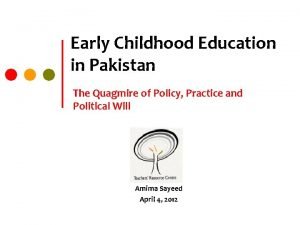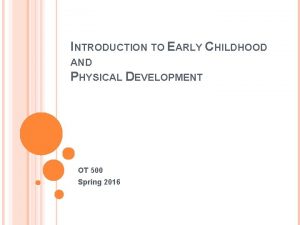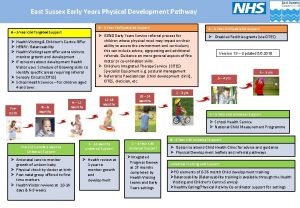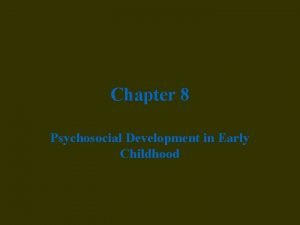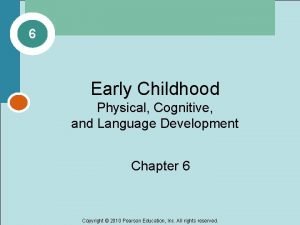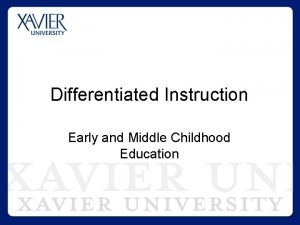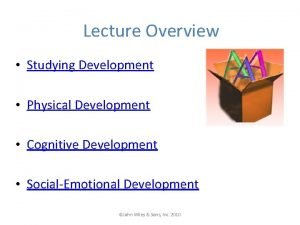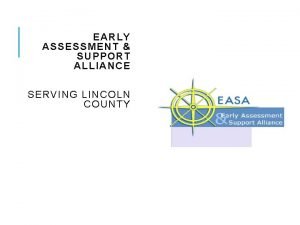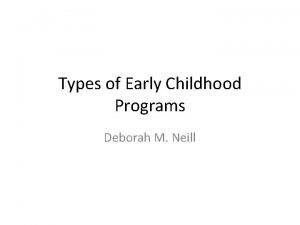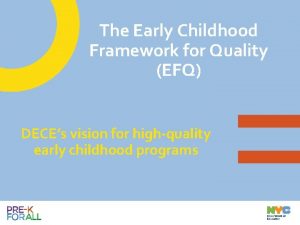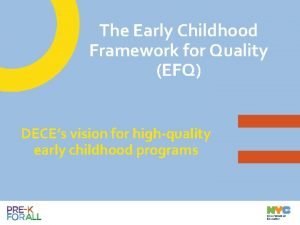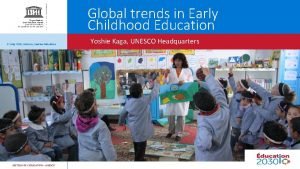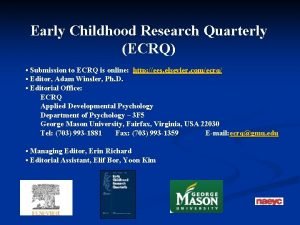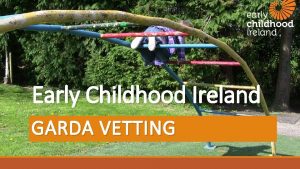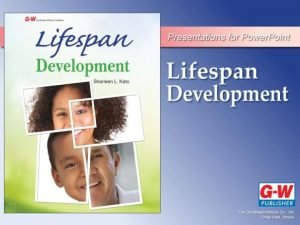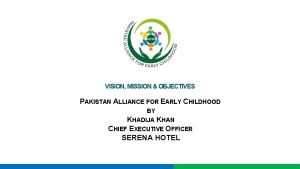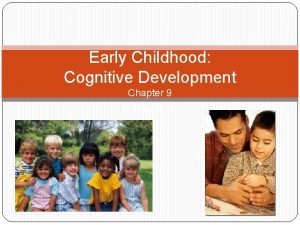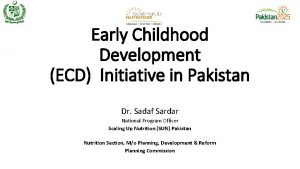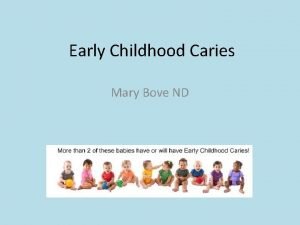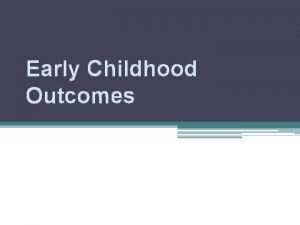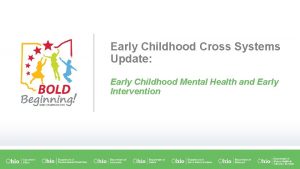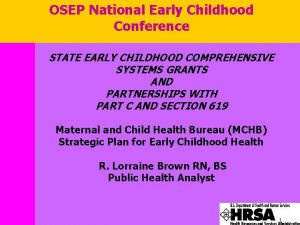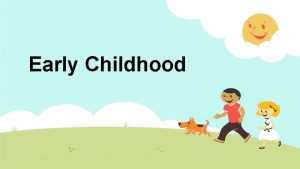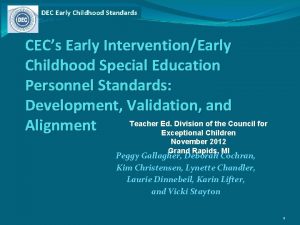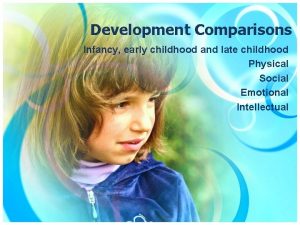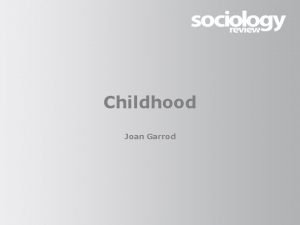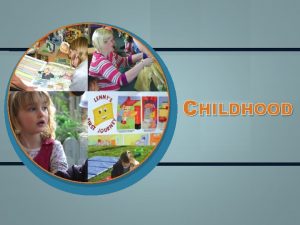AN OVERVIEW OF EARLY CHILDHOOD DEVELOPMENT PAKISTAN ALLIANCE
























- Slides: 24

AN OVERVIEW OF EARLY CHILDHOOD DEVELOPMENT PAKISTAN ALLIANCE FOR EARLY CHILDHOOD BY KHADIJA KHAN CHIEF EXECUTIVE OFFICER SERENA HOTEL

Why Early Childhood Development is Critical? • Holistic development (cognitive, physical, emotional and social) provides sound foundation for the rest of a person’s life • During the first 1000 days, children’s brain can form 700 to 1, 000 neural connections every second which are the building blocks of their future. Therefore, first 1, 000 days of life have a profound impact on brain development

The First 1, 000 Days of Life • The first 1000 days beginning at the time of conception on to a baby’s second birthday Pregn ancy 270 Days November 3, 2020 Year 2 Year 1 + 365 Days First + 365 Days = 1000 Days 3

Brain Development • Born with 100 billion brain cells • All the neurons have the same genetic potential • Our brain is Sensitive and Reactive and further development of connections is dependent on stimuli from the sensory pathways • Upto 15, 000 synaptic connections may be established for each cell • Signals can be sent to other cells at speeds of more than 200 mph • 75% of brain development occurs by age 1 and 90% by age 3 November 3, 2020 4

Critical Point of Intervention Critical Point of Brain Development Window of Opportunity • At birth, 25% • At age 1, 75% • At age 3, 90%

The Plasticity of Brain Architecture Decreases over Time • The neuroplasticity formed at the early age underlies a child’s physical and mental health, life long capacity to learn, adapt to change and develop psychological resilience • Brain has more plasticity in early years and its capacity for change decreases with age • Accommodates a wide range of environments and interaction during early years • Early Plasticity makes the brain both more vulnerable to harm and more capable of recovery • Window of opportunity for different type of skills November 3, 2020 6

Example of sensitive periods: • Basic vision and hearing which develop first; • Early language skills and higher cognitive functions which develop later

New Evidence Advancing ECD: A Life Course Perspective Reach Developmental Potential NURTURING CARE: • Health Preconception and pregnancy Parenting Adolescence and adulthood • Nutrition • Security & Safety • Responsive Caregiving Multi-generational life course of development, health, and well-being • Early Learning Newborn Mid-childhood Early childhood Enabling Environment for Caregiver, Family, Community Social, Economic, Political, Climatic, Cultural Contexts

Early Childhood Stress Influences Brain Development November 3, 2020 9

Neglect Impedes Brain Development • Limited exposure to language, touch or social interactions • Emotional or cognitive neglect • Physical Threat • Early, frequent and intense threat • Structural Changes November 3, 2020 10

Cumulative Vocabulary (Words) Disparities in Early Vocabulary Growth 1200 1000 Children of College Educated 800 600 400 Children of Lower Middle Class Children of Parents in Poverty 200 16 mos. 24 mos. Child’s Age (Months) 36 mos. Source: Hart & Risley (1995)

‘Serve and Return’ Relationship • The interactive influences of genes and experience shape the developing brain; genes provide the blue print for brain development, but environment shapes it • Brain development occurs through the brain’s active engagement in everyday experience • Major ingredient in the developmental process is the ‘Serve and Return’ interactions November 3, 2020 12

Rates of Return to Human Development Investment Across all Ages ‘Policy makers should invest in young children where the return on investment is stronger than in low-skilled adults’ James Heckman, a Nobel-prize winning economist November 3, 2020 13

A compelling investment Children who get the right nutrition during the first 1000 days: • Are 10 times more likely to overcome the most life threatening child diseases • Complete 4. 6 more grades at school • Go on to earn 21% more in wages as adults • Are more likely as adults to have healthier families

SDGs – a unique and significant opportunity to drive integrated transformation in ECD • • • Goal 1: ECD is cost effective Goal 2: Stimulation and nutrition Goal 3: Healthy lives, long healthy life Goal 4: Lifelong learning begins at birth Goal 5: Gender equality, greater investment in quality childcare Goal 8: Promote decent work, professionalization of caregivers Goal 10: Reducing Inequalities Goal 11: Safe cities, ECD spaces, natural love for environment Goal 16: Peaceful societies

Situation of children – Under 5 In low and middle-income countries • 43% at risk of not achieving development potential • 75 million live in areas affected by conflict, exposed to toxic stress, potentially inhibiting brain cell connections • 155 million are stunted, which prevents brain development • 25% of 2 -4 year olds (in 64 countries) do not have opportunities essential for brain development such as playing, reading and singing • 300 million live in areas with toxic air, which can damage their developing brains Early moments Matter –UNICEF for every child 2017

ECD: Uncertain Times Pakistan • Millions of children risk not meeting developmental potential • Poverty • Widespread malnutrition - children and maternal • Lack of stimulation, exposure to environmental hazards • 44% of children < 5 years old stunted • 23. 7% net enrollment in pre-primary school Many challenges complicate ECD Little or no investment in ECD Limited progress in addressing basic determinants Population growth Urban migration Natural disasters Socio-political instability and conflict

ECD Programming in Pakistan • Vision 2025 by Ministry Of Planning & Development • NHSR&C and Do. H: - MNCH Programme Multi-sectoral Nutrition Programme Infant Young Child Feeding Strategy(IYCF) Expanded Programme on Immunisation • Ministry of Education & Education Departments - Section on ECE in the National Education Policy 2017 Revision of Curriculum on ECE in 2017 Development of books for age 4 -5 based on NC Of ECCE Development of ECE Policy & stratgies in provinces & alignment of Education Sector Plans with SDGs

INGOs working on ECD • • • • UNICEF UNESCO WHO WFP World Bank DFi. D USAID AUSAID Save the Children Plan International Foundation Open Society European Commission World Learning BRAC

NGOs working on ECD • • • • RUPANI FOUNDATION Aga Khan Development Network(AKDN) RSPN Idar-i-Taleem-o-Aagahi PARWAAN Right to Play HANDS Society Sindh Education Foundation Teachers’ Resource Center(TRC) HASHOO FOUNDATION BUNYAAD Individual Initiatives

Academia • Universities • Education Colleges • Private Training Institutions • Research Centers • Private School System

SDGs – a unique and significant opportunity to drive integrated transformation in ECD • How do we help children to develop their potential in their diverse cultures and contexts? • How do we help to prepare 21 st century children for a safe and harmonious planet in a dynamic, pluralistic, technological world? • How do we help children to have the ability to handle complex information, be flexible, adaptable, problem-solvers, creative and critical thinkers? • How do we nurture children to put themselves in another person’s shoes?

ECD: From ‘Why’ to ‘How’(Slide prepared by Dr Almina Pardhan) Leverage on SDGs for integrated transformation Collective commitment to action Multisector approach: polices, planning, monitoring Visibility of ECD in national and provincial budgets Urgently invest in children Systems-based approach, integrated into existing platforms Research Study and learn from lo— cost intervention models Scale-up models Family & child friendly policies and services Contextualize community messages Increase protection for children

A nation is only as good as its children – let us invest in our future by investing in Early Child Development November 3, 2020 24
 Prosposed
Prosposed Ece in pakistan
Ece in pakistan Principles of growth and development
Principles of growth and development Fine motor skills development in early childhood
Fine motor skills development in early childhood Physical development in early childhood
Physical development in early childhood Psychosocial development in early childhood
Psychosocial development in early childhood Language development in early childhood
Language development in early childhood A vygotskian classroom promotes ________.
A vygotskian classroom promotes ________. Biosocial child development
Biosocial child development Early childhood development with differentiated instruction
Early childhood development with differentiated instruction 3 stages of prenatal development
3 stages of prenatal development Early assessment and support alliance
Early assessment and support alliance Eylf meaning
Eylf meaning Types of early childhood programs
Types of early childhood programs Chapter 2 types of early childhood programs
Chapter 2 types of early childhood programs Efq element 1
Efq element 1 Early childhood framework for quality
Early childhood framework for quality Pdp early childhood education and training program
Pdp early childhood education and training program Welcome dear parents
Welcome dear parents Nsw department of education
Nsw department of education Leonardo da vinci's childhood
Leonardo da vinci's childhood Trends in early childhood education
Trends in early childhood education Early childhood research quarterly author guidelines
Early childhood research quarterly author guidelines Early childhood ireland garda vetting
Early childhood ireland garda vetting Chapter 7 early childhood ages 3 through 5
Chapter 7 early childhood ages 3 through 5

